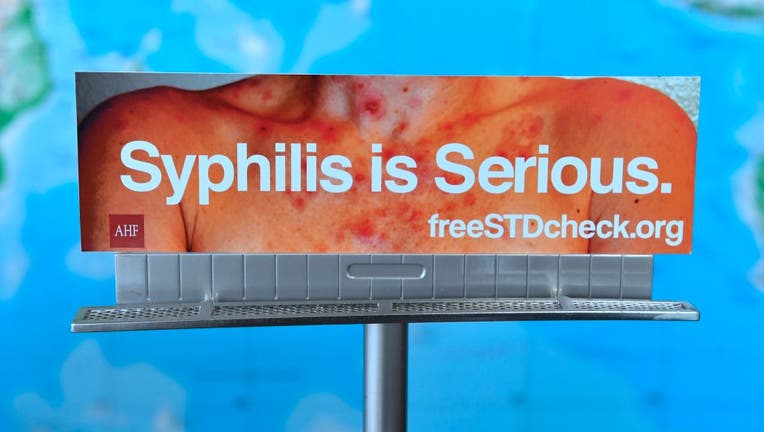Syphilis reaches 1950s levels in US, while other STD rates show mixed trends

A model of a billboard from the AIDS Healthcare Foundation (AHF) which ran in Los Angeles earlier this year but has been rejected to be displayed in many other cities is seen at the AHF office in Hollywood, California on May 18, 2018. (Photo credit s
NEW YORK (AP) - The U.S. syphilis epidemic isn't abating, with the rate of infectious cases rising 9% in 2022, according to a new federal government report on sexually transmitted diseases in adults.
But there's some unexpected good news: The rate of new gonorrhea cases fell for the first time in a decade.
It's not clear why infectious cases of syphilis rose 9% while gonorrhea dropped 9%, officials at the U.S. Centers for Disease Control and Prevention said, adding that it's too soon to know whether a new downward trend is emerging for the latter.
RELATED: America's most bed bug infested cities may surprise you
They are most focused on syphilis, which is less common than gonorrhea or chlamydia but considered more dangerous. And while it continues to have a disproportionate impact on gay and bisexual men, it is expanding in heterosexual men and women, and increasingly affecting newborns, too, CDC officials said.
Total cases surpassed 207,000 in 2022, a 17% increase and the highest count in the United States since 1950, according to data released Tuesday. The count includes not only the most infectious stages of the disease but also latent cases and cases in which pregnant women passed syphilis on to their babies.
Syphilis is a bacterial disease that can surface as painless genital sores but can ultimately lead to paralysis, hearing loss, dementia and even death if left untreated.
RELATED: Respiratory illnesses remain 'elevated' throughout much of country: CDC
New syphilis infections plummeted in the U.S. starting in the 1940s when antibiotics became widely available and fell to their lowest by 1998.
About 59,000 of the 2022 cases involved the most infectious forms of syphilis. Of those, about a quarter were women and nearly a quarter were heterosexual men.
"I think it's unknowingly being spread in the cisgender heterosexual population because we really aren’t testing for it. We really aren't looking for it" in that population, said Dr. Philip Chan, who teaches at Brown University and is chief medical officer of Open Door Health, a health center for gay, lesbian and transgender patients in Providence, Rhode Island.
Steps to prioritizing mental health in 2024
Starting off the new year fresh may include new goals or resolutions. If you want to achieve your goals, you may want to put a focus on prioritizing your mental health, says licensed mental health counselor Cherlette McCullough. She shares ways you can put your mental health first as you look forward to a healthier and happier new year.
The report also shows rates of the most infectious types of syphilis rose not just across the country but also across different racial and ethnic groups, with American Indian and Alaska Native people having the highest rate. South Dakota outpaced any other state for the highest rate of infectious syphilis at 84 cases per 100,000 people — more than twice as high as the state with the second-highest rate, New Mexico.
South Dakota's increase was driven by an outbreak in the Native American community, said Dr. Meghan O’Connell, chief public health officer at the Great Plains Tribal Leaders’ Health Board based in Rapid City, South Dakota. Nearly all of the cases were in heterosexual people, and O'Connell said that STD testing and treatment was already limited in isolated tribal communities and only got worse during the pandemic.
RELATED: Cancer cases increasing in US, but overall deaths decreasing, new research shows
The U.S. Department of Health and Human Services last year convened a syphilis task force focused on stopping the spread of the STD, with an emphasis on places with the highest syphilis rates — South Dakota, 12 other states and the District of Columbia.
The report also looked at the more common STDs of chlamydia and gonorrhea.
Chlamydia cases were relatively flat from 2021 to 2022, staying at a rate of about 495 per 100,000, though there were declines noted in men and especially women in their early 20s. For gonorrhea, the most pronounced decline was seen in women in their early 20s as well.
Experts say they're not sure why gonorrhea rates declined. It happened in about 40 states, so whatever explains the decrease appears to have occurred across most of the country. STD testing was disrupted during the COVID-19 pandemic, and officials believe that's the reason the chlamydia rate fell in 2020.
It's possible that testing and diagnoses were still shaking out in 2022, said Dr. Jonathan Mermin, director of the CDC’s National Center for HIV, Viral Hepatitis, STD and TB Prevention.
"We are encouraged by the magnitude of the decline," Mermin said, though the gonorrhea rate is still higher now than it was pre-pandemic. "We need to examine what happened, and whether it's going to continue to happen."
The Associated Press Health and Science Department receives support from the Howard Hughes Medical Institute’s Science and Educational Media Group. The AP is solely responsible for all content.

